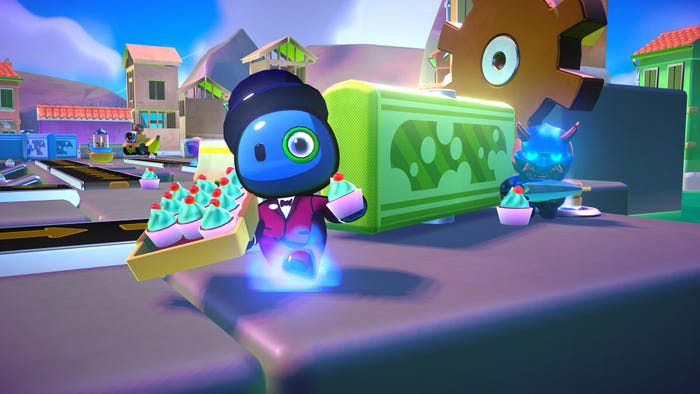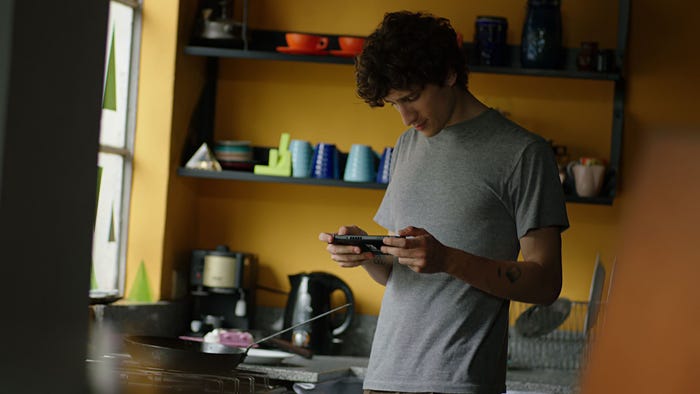
Featured Blog | This community-written post highlights the best of what the game industry has to offer. Read more like it on the Game Developer Blogs.
Cooperative VR Design lessons learned from a UC Santa Cruz indie team's upcoming horror game for the Oculus Rift.

At the beginning of 2016, we set out to explore a realm of game design we hadn't seen done before - disjoint, 2-player puzzles in VR. In our game Shackle, players find themselves back to back in a haunted room, divided by darkness. Seeing opposite halves of the room, they must coordinate actions while maintaining a low profile in order to escape, or face certain doom.
Players rely on one another to see and interact with what's behind them.
When development began, we found ourselves designing in darkness - while there are plenty of puzzle, horror, and cooperative games to research, we had trouble finding any with the same constraints. The closest we found was the popular Keep Talking and Nobody Explodes, which uses a single VR headset to "blindfold" the players from one another. While this certainly gave us a frame of reference, there was no denying that we were going to have to dive head-first into the abyss, and start developing designs we thought would work. After putting our vertical slice in front of fresh eyes, we quickly began to learn what was working - and what wasn’t.
To put these ideas into context, let's take a look at them in reference to a simple puzzle - unlocking a combination lock. Players (let's call them Jerry and George) must do the following to complete this task:
1.) Jerry must notice a torn map with an incomplete sequence of numbers on it.
2.) George must open a desk drawer to find a shred of the map with the rest of the numbers on it.
3.) Jerry and George must piece together the entire sequence, and use it as the code to unlock the lock.
Here's the rules that helped us make this dynamic feel natural:
Connect puzzle elements -- During playtesting, we quickly found that puzzle elements which required no action or consultation from the other player often fell flat. Ensuring that elements require a verbal and/or physical input from the other player has helped cut out these flat parts. In the case of the lock, we maintained this by distributing part of the code sequence to each player, requiring them to communicate to uncover the entire code. We realized that in order for Shackle's unique layout to work, all puzzles would need to be deeply integrated with this structure in mind.
Facilitate memorable dialogue -- Since players can't see each others' experiences, they should be easy to communicate and also worth sharing. We first discovered this when we decided make the lock's combination a subtle reference to a well-known song on a whim. It typically led to some comical, calming discussion between players among an otherwise suspenseful and frightening experience.
Make understandable objects -- In order for players to collaboratively solve puzzles, they need to be able to accurately describe their environments to one another. When an object's perceived functionality doesn't match its actual functionality, it makes solving the puzzles difficult for the wrong reason. Early on, we found that most players weren't picking up on the fact that the desk drawer could be opened. By redesigning the drawer's model with a bigger handle to better afford pulling, we were able to effectively squash this misconception.
Cleverly present instructions -- With virtual reality's recent and expensive introduction to the market, we've found that most of our playtesters haven't experienced VR firsthand before. This means most are easily amazed by the initial experience - just looking around is entertaining. As a result, our in-game attempts to explain controls and gameplay were often overlooked. To make sure players know how to interact with objects like the lock, we landed on displaying tips like this:
Cleverly present instructions (cont.) -- By showing the entire controller when displaying controls, it allows players to feel around for the necessary input rather than having to take the headset off and look at the controller. Additionally, these tips only dismiss themselves once the associated input has completed, thus confirming that players understand the tip, and ensuring it doesn't dismiss itself before they see it.
Never stop learning -- Exploring a new design space is exciting, but it can also be daunting. What's important is that we've found success amidst our playtesting, showing that our concept has potential. Uncertainty aside, we're excited to continue exploring this new design space and launch Shackle!
With just 5 weeks left until release we're doing our best to continue learning and polishing our experience. If you're interested in updates on the project, or just supporting our crazy endeavor, give us a follow!
Twitter: @ShackleGame
Read more about:
Featured BlogsAbout the Author(s)
You May Also Like








